Themed collection Quantum and carbon dots

A review on the cytotoxicity of graphene quantum dots: from experiment to simulation
Schemetic diagram of the mechanism of GQD-induced cytotoxicity.
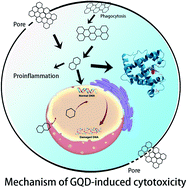
Nanoscale Adv., 2021,3, 904-917
https://doi.org/10.1039/D0NA00904K
Recent advancements in the applications of carbon nanodots: exploring the rising star of nanotechnology
Nanoparticles possess fascinating properties and applications, and there has been increasing critical consideration of their use.

Nanoscale Adv., 2020,2, 1760-1773
https://doi.org/10.1039/C9NA00794F
Biomolecule-derived quantum dots for sustainable optoelectronics
The recent advances in sustainable optoelectronics applications of quantum dots derived from different biomolecules are documented in this review.
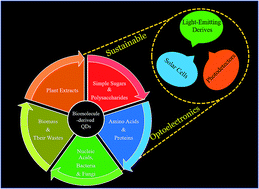
Nanoscale Adv., 2019,1, 913-936
https://doi.org/10.1039/C8NA00332G
The quantum dot-FRET-based detection of vitamin B12 at a picomolar level
The picomolar level detection of vitamin B12 using orange-emitting Mn2+-doped ZnS quantum dots is described herein.
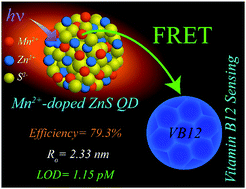
Nanoscale Adv., 2020,2, 3809-3814
https://doi.org/10.1039/D0NA00540A
Long-term ambient air-stable cubic CsPbBr3 perovskite quantum dots using molecular bromine
Temperature and precursor-controlled in situ generated, oleylammonium halide species from molecular bromine and amine plays decisive role in the synthesis of long-term ambient stable and emission tunable CsPbBr3 perovskite nanocrystals.

Nanoscale Adv., 2019,1, 3388-3391
https://doi.org/10.1039/C9NA00486F
Selective photothermal killing of cancer cells using LED-activated nucleus targeting fluorescent carbon dots
Effective theranostic probes in cancer therapy are still a challenge. We report the selective killing of cancer cells upon photothermal ablation using a new class of 2,5-deoxyfructosazine-coated green-emissive carbon dots using mild LED-irradiation.
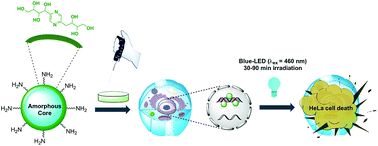
Nanoscale Adv., 2019,1, 2840-2846
https://doi.org/10.1039/C9NA00293F
Correlation of near-unity quantum yields with photogenerated excitons in X-type ligand passivated CsPbBr3 perovskite quantum dots
The TCSPC analysis revealed that DDT-PQDs mainly performed single radiative decay, whereas PQDs showed additional slow nonradiative decay with rise of temperature.
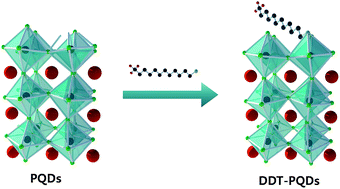
Nanoscale Adv., 2019,1, 2828-2834
https://doi.org/10.1039/C9NA00292H
Carbon dots derived from algae as H2O2 sensors: the importance of nutrients in biomass
Effect of mineral nutrients in biomass was found to be crucial in the synthesized carbon dots, affecting their dispersibility, PL stability and crystallinity.
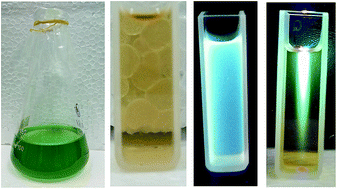
Nanoscale Adv., 2019,1, 2151-2156
https://doi.org/10.1039/C9NA00049F
Bioinspired carbon dots: from rose petals to tunable emissive nanodots
The present study addresses the limitation of versatility in green precursors by exploring the formation of carbon dots with respect to the contents of green precursor, i.e. Rosa indica. The synthesis mechanism is elucidated by analysing the precursors and intermediates at different intervals.

Nanoscale Adv., 2019,1, 1290-1296
https://doi.org/10.1039/C8NA00105G
Optically active quantum dots with induced circularly polarized luminescence in amphiphilic peptide dendron hydrogel
Semiconductor quantum dots showing controlled circularly polarized luminescence were achieved through co-assembling with chiral peptide dendron gelator in water.
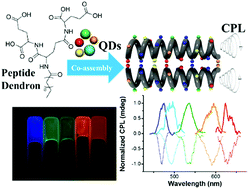
Nanoscale Adv., 2019,1, 508-512
https://doi.org/10.1039/C8NA00216A
Nitrogen-doped carbon dots for sensitive detection of ferric ions and monohydrogen phosphate by the naked eye and imaging in living cells
Nitrogen doped carbon dots (N-CDs) have been prepared via a one-pot hydrothermal method by using formamide and o-phenylenediamine as the carbon precursors for Fe3+ and HPO42− detection.

Nanoscale Adv., 2021,3, 805-811
https://doi.org/10.1039/D0NA00769B
Surface modifications of carbon nanodots reveal the chemical source of their bright fluorescence
Carbon nanodots were chemically modified to control the fluorescence and identify fluorophores.
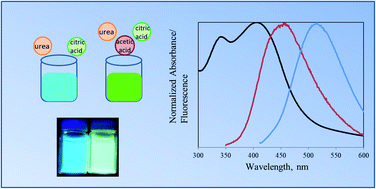
Nanoscale Adv., 2021,3, 716-724
https://doi.org/10.1039/D0NA00871K
Phosphorescent MoS2 quantum dots as a temperature sensor and security ink
The embedding of MoS2 quantum dots in polyvinyl alcohol matrices produces long afterglow phosphorescent materials.
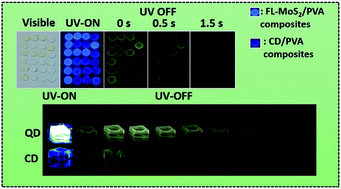
Nanoscale Adv., 2021,3, 661-667
https://doi.org/10.1039/D0NA00730G
Stimuli responsive multicolour fluorescence emission in carbon nanodots and application in metal free hydrogen evolution from water
Visible light sensitive stimuli responsive fluorescent carbon dots have been fabricated and utilized for metal free hydrogen evolution from water.
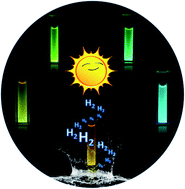
Nanoscale Adv., 2021,3, 611-617
https://doi.org/10.1039/D0NA00799D
Tyrosine carbon dots inhibit fibrillation and toxicity of the human islet amyloid polypeptide
Carbon dots prepared from tyrosine and citric acid inhibit fibrillation, membrane interactions and toxicity of hIAPP.
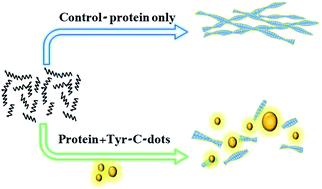
Nanoscale Adv., 2020,2, 5866-5873
https://doi.org/10.1039/D0NA00870B
A zeolite-based ship-in-a-bottle route to ultrasmall carbon dots for live cell labeling and bioimaging
The smallest-pore SAPO-20 zeolite confined pyrolysis of organics afforded ultrasmall uniform carbon dots with excellent performance in bioimaging.
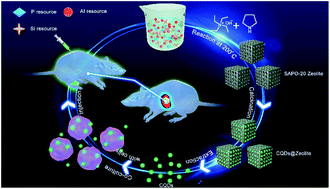
Nanoscale Adv., 2020,2, 5803-5809
https://doi.org/10.1039/D0NA00664E
Surface vs. core N/S/Se-heteroatom doping of carbon nanodots produces divergent yet consistent optical responses to reactive oxygen species
This study explores chemical changes that occur to five carbon nanodots upon exposure to oxidants, and relates these to changes of their optical properties.

Nanoscale Adv., 2020,2, 4024-4033
https://doi.org/10.1039/D0NA00439A
Strong suppression of emission quenching in core quantum dots coupled to monolayer MoS2
We report control of the emission efficiency of core QDs in MoS2–QD hetero-structure. At smaller separations we observe enhanced emission from QDs on MoS2 as compared to the reference despite the presence of significant non-radiative processes.
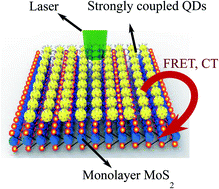
Nanoscale Adv., 2020,2, 3858-3864
https://doi.org/10.1039/D0NA00384K
Optical and electrochemical tuning of hydrothermally synthesized nitrogen-doped carbon dots
Using a novel hydrothermal synthesis, nitrogen-doped carbon dots were synthesized and shown to exhibit tunable optical and electrochemical properties.

Nanoscale Adv., 2020,2, 3375-3383
https://doi.org/10.1039/D0NA00264J
Enhancement of organic solar cell performance by incorporating gold quantum dots (AuQDs) on a plasmonic grating
The performance of organic solar cells was improved by the effect of a synergistic gold quantum dot/plasmonic grating system.
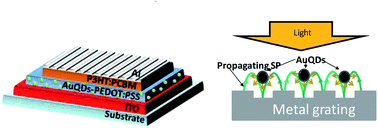
Nanoscale Adv., 2020,2, 2950-2957
https://doi.org/10.1039/D0NA00169D
A facile synthesis of two ionized fluorescent carbon dots and selective detection toward Fe2+ and Cu2+
Two ionized carbon dots were prepared with different optical properties and applied for the selective detection of Fe2+ and Cu2+.
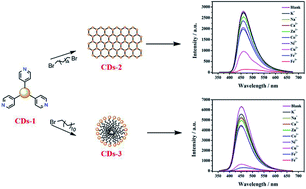
Nanoscale Adv., 2020,2, 2943-2949
https://doi.org/10.1039/D0NA00151A
In situ assembly of a graphene oxide quantum dot-based thin-film nanocomposite supported on de-mixed blends for desalination through forward osmosis
Enhanced forward osmosis desalination and dye rejection achieved via a unique thin-film composite membrane designed using polyamide–GQD framework on hierarchically arranged porous membrane derived from de-mixed blends of PVDF/PMMA.
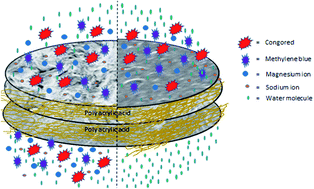
Nanoscale Adv., 2020,2, 1993-2003
https://doi.org/10.1039/C9NA00688E
Light extraction from quantum dot light emitting diodes by multiscale nanostructures
Green emitting QLEDs based on multiscale grid/wrinkle outcoupling nanostructures yield a maximum EQE of 21.3% and current efficiency of 88.3 cd A−1, which are 1.7 times those of the standard device.
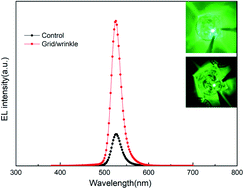
Nanoscale Adv., 2020,2, 1967-1972
https://doi.org/10.1039/D0NA00150C
Carbon source self-heating: ultrafast, energy-efficient and room temperature synthesis of highly fluorescent N, S-codoped carbon dots for quantitative detection of Fe(III) ions in biological samples
A novel carbon source self-heating strategy for ultrafast, energy-efficient and scalable synthesis of highly PL N, S-codoped CDs was established and used for sensing Fe3+ in an ultra-wide range of 0.2–600 μM, with a detection limit of 0.10 μM.

Nanoscale Adv., 2020,2, 1483-1492
https://doi.org/10.1039/C9NA00806C
A broadband ultraviolet light source using GaN quantum dots formed on hexagonal truncated pyramid structures
Broadband ultraviolet solid-state light emitter has been demonstrated based on the combined structure of MOCVD grown microstructure and the MBE grown quantum dots, thanks to the strain inhomogeneity of the multi-facet semiconductor microstructure.

Nanoscale Adv., 2020,2, 1449-1455
https://doi.org/10.1039/D0NA00052C
Antimicrobial activity of graphene oxide quantum dots: impacts of chemical reduction
The design and engineering of graphene-based nanomaterials for antimicrobial applications is attracting extensive interest. Here, we highlight the differential toxicity and phototoxicity of graphene oxide quantum dots after NaBH4 reduction.

Nanoscale Adv., 2020,2, 1074-1083
https://doi.org/10.1039/C9NA00698B
A novel strategy to design a multilayer functionalized Cu2S thin film counter electrode with enhanced catalytic activity and stability for quantum dot sensitized solar cells
Multilayer Cu2S/ITO/CuZnMo films are designed as CEs for QDSCs, having the merits of enhanced conductivity and stability, and high catalytic activity.
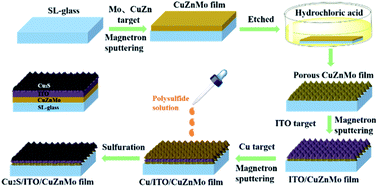
Nanoscale Adv., 2020,2, 833-843
https://doi.org/10.1039/C9NA00654K
The detection and identification of dengue virus serotypes with quantum dot and AuNP regulated localized surface plasmon resonance
A fluorometric sensing system using LSPR phenomenon between fluorescent quantum dots and its adjacent AuNP to detect four closely related but serologically distinct dengue viruses (DENVs).

Nanoscale Adv., 2020,2, 699-709
https://doi.org/10.1039/C9NA00763F
A near infrared dye-coated silver nanoparticle/carbon dot nanocomposite for targeted tumor imaging and enhanced photodynamic therapy
A NIR dye-coated silver nanoparticle/carbon dot nano-composite (CyOH–AgNP/CD) was synthetized as a novel nanophotosensitizer for targeted tumor imaging and high-efficiency PDT. The CyOH–AgNP/CD exhibit potential for future clinical imaging-guided PDT.
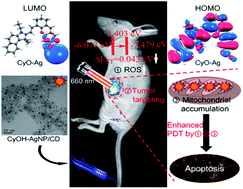
Nanoscale Adv., 2020,2, 489-494
https://doi.org/10.1039/C9NA00596J
Room-temperature solution-phase epitaxial nucleation of PbS quantum dots on rutile TiO2 (100)
We demonstrate epitaxial nucleation of QDs onto titania by the successive ionic layer adsorption and reaction (SILAR) method at room temperature.

Nanoscale Adv., 2020,2, 377-383
https://doi.org/10.1039/C9NA00601J
Improvement in hole transporting ability and device performance of quantum dot light emitting diodes
A new additive BYK-P105 was blended with PEDOT:PSS as the HTL to improve the device performance of QLEDs.
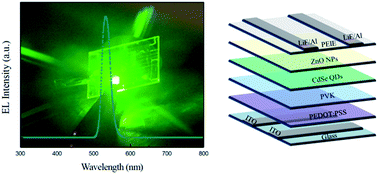
Nanoscale Adv., 2020,2, 401-407
https://doi.org/10.1039/C9NA00618D
The effect of ZnO/ZnSe core/shell nanorod arrays photoelectrodes on PbS quantum dot sensitized solar cell performance
ZnO nanorod (NR) based inorganic quantum dot sensitized solar cells have gained tremendous attention for use in next generation solar cells.

Nanoscale Adv., 2020,2, 286-295
https://doi.org/10.1039/C9NA00523D
High-performance laminated luminescent solar concentrators based on colloidal carbon quantum dots
A carbon-quantum-dot based laminated luminescent solar concentrator exhibits an ηopt of 1.6%, 1.6 times higher than that of a single-layer LSC.

Nanoscale Adv., 2019,1, 4888-4894
https://doi.org/10.1039/C9NA00527G
PbS quantum dots as additives in methylammonium halide perovskite solar cells: the effect of quantum dot capping
Colloidal PbS quantum dots (QDs) have been successfully employed as additives in halide perovskite solar cells (PSCs) acting as nucleation centers in the perovskite crystallization process.

Nanoscale Adv., 2019,1, 4109-4118
https://doi.org/10.1039/C9NA00475K
A feasible strategy to prepare quantum dot-incorporated carbon nanofibers as free-standing platforms
A feasible strategy to prepare quantum dot-incorporated carbon nanofibers as free-standing platforms and their possible application to photocatalysts.
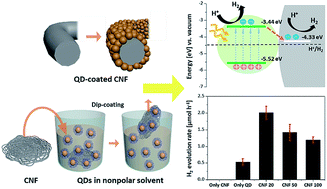
Nanoscale Adv., 2019,1, 3948-3956
https://doi.org/10.1039/C9NA00423H
The dynamic surface chemistry of colloidal metal chalcogenide quantum dots
Probing the interactions of ligands at the surface of colloidal quantum dots by NMR measurements of diffusion coefficients and spectral line widths.

Nanoscale Adv., 2019,1, 3639-3646
https://doi.org/10.1039/C9NA00452A
Quantum dot cellular uptake and toxicity in the developing brain: implications for use as imaging probes
Nanometer-sized luminescent semiconductor quantum dots (QDs) have been utilized as imaging and therapeutic agents in a variety of disease settings, including diseases of the central nervous system.
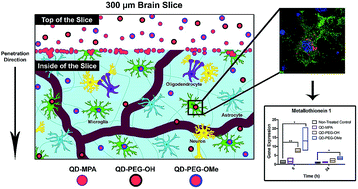
Nanoscale Adv., 2019,1, 3424-3442
https://doi.org/10.1039/C9NA00334G
Quantum dot based 3D printed woodpile photonic crystals tuned for the visible
3D printed woodpile photonic crystals functionalized with CdS quantum dots are tuned for visible applications.
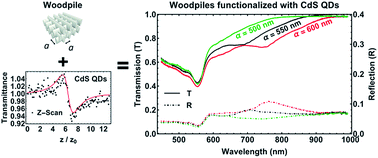
Nanoscale Adv., 2019,1, 3413-3423
https://doi.org/10.1039/C9NA00357F
Novel nitrogen doped carbon dots enhancing the anticorrosive performance of waterborne epoxy coatings
Simple, versatile, and cost-effective carbon dots are reported for initiating interfacial bonding in waterborne epoxy resin anti-corrosive coatings.
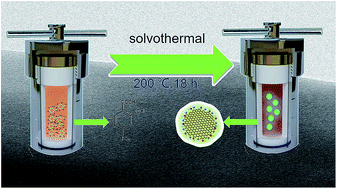
Nanoscale Adv., 2019,1, 3443-3451
https://doi.org/10.1039/C9NA00155G
Hydrothermal synthesis of carbon nanodots from bovine gelatin and PHM3 microalgae strain for anticancer and bioimaging applications
Semi-conductor quantum dots (QDs) are favorite candidates for many applications especially for potential use as optical bioimaging agents.
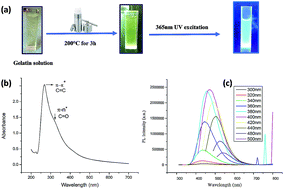
Nanoscale Adv., 2019,1, 2924-2936
https://doi.org/10.1039/C9NA00164F
Rapid synthesis of hybrid methylammonium lead iodide perovskite quantum dots and rich MnI2 substitution favouring Pb-free warm white LED applications
We present a facile room temperature synthesis of CH3NH3Pb1−xMnxI3 perovskite quantum dots (PQDs) substituting manganese (Mn2+) at the lead (Pb2+) sites to minimize environmental pollution and make it commercially feasible.
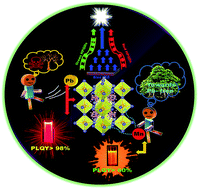
Nanoscale Adv., 2019,1, 2999-3008
https://doi.org/10.1039/C9NA00330D
Parameters affecting the synthesis of carbon dots for quantitation of copper ions
A simple, eco-friendly, and low-cost electrochemical approach has been applied to the synthesis of carbon dots from histidine hydrochloride in the absence or presence of halides at various potentials up to 10 V.
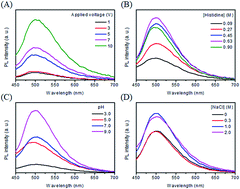
Nanoscale Adv., 2019,1, 2553-2561
https://doi.org/10.1039/C9NA00137A
Nucleotide-derived theranostic nanodots with intrinsic fluorescence and singlet oxygen generation for bioimaging and photodynamic therapy
We report a new way to engineer nanomaterials from biomolecules (N-dots) with bright fluorescence and high singlet oxygen generation towards theranostic applications.

Nanoscale Adv., 2019,1, 2250-2257
https://doi.org/10.1039/C9NA00058E
An ultrafast quantum thermometer from graphene quantum dots
We report an ultra-sensitive temperature sensor derived from graphene quantum dots (GQDs) embedded in a self-standing reduced graphene oxide (RGO) film.
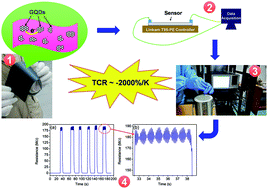
Nanoscale Adv., 2019,1, 1772-1783
https://doi.org/10.1039/C8NA00361K
Large-scale synthesis of carbon dots/TiO2 nanocomposites for the photocatalytic color switching system
In view of the easy control and contactless spatial nature of light, the photoreversible color switching system has attracted tremendous attention.
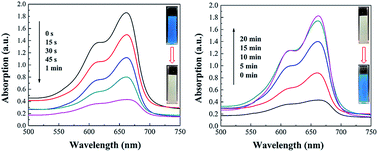
Nanoscale Adv., 2019,1, 1819-1825
https://doi.org/10.1039/C9NA00054B
Systematic experimental study of quantum interference effects in anthraquinoid molecular wires
In order to translate molecular properties in molecular-electronic devices, it is necessary to create design principles that can be used to achieve better structure–function control oriented toward device fabrication.
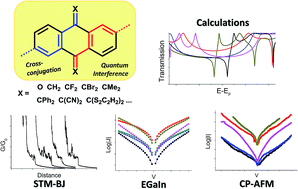
Nanoscale Adv., 2019,1, 2018-2028
https://doi.org/10.1039/C8NA00223A
Temperature-controlled spectral tuning of full-color carbon dots and their strongly fluorescent solid-state polymer composites for light-emitting diodes
Temperature-controlled, scalable synthesis of CA-based full-color CDs and subsequent fabrication of white-LEDs with CIE coordinates of (0.32, 0.33) and a CRI of 82.7.
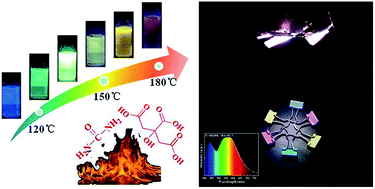
Nanoscale Adv., 2019,1, 1413-1420
https://doi.org/10.1039/C8NA00329G
2D-MoS2 nanosheets as effective hole transport materials for colloidal PbS quantum dot solar cells
Herein, we demonstrate for the first time matrix-free deposition of two dimensional (2D) MoS2 nanosheets as an efficient hole transport layer (HTL) for colloidal lead sulfide (PbS) quantum dot (QD) solar cells.
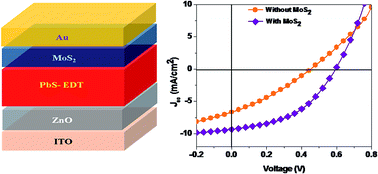
Nanoscale Adv., 2019,1, 1387-1394
https://doi.org/10.1039/C8NA00272J
Investigation of a gold quantum dot/plasmonic gold nanoparticle system for improvement of organic solar cells
The performance of organic solar cells was improved by the effect of a synergistic gold quantum dot/plasmonic gold nanoparticle system.

Nanoscale Adv., 2019,1, 792-798
https://doi.org/10.1039/C8NA00119G
Interfacial engineering of carbon dots with benzenediboronic acid for fluorescent biosensing
Glucose assay is highly important in clinical diagnostics of diabetes.
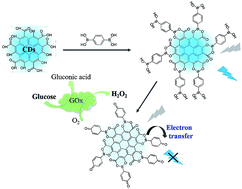
Nanoscale Adv., 2019,1, 765-771
https://doi.org/10.1039/C8NA00166A
Configuration- and concentration-dependent hybrid white light generation using red, green, and blue quantum dots embedded in DNA thin films
A simple and hybrid white-light optoelectronic device with a single excitation source with efficient RGB colours on a stable optical platform was demonstrated.
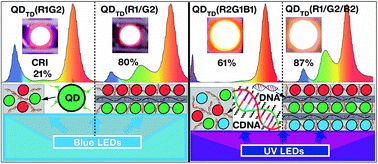
Nanoscale Adv., 2019,1, 602-612
https://doi.org/10.1039/C8NA00252E
Nitrogen-doped carbon dots as fluorescence ON–OFF–ON sensor for parallel detection of copper(II) and mercury(II) ions in solutions as well as in filter paper-based microfluidic device
Fluorescent nitrogen doped carbon dots show parallel detection of Hg2+ and Cu2+ ions in both aqueous medium and on microfluidic device.
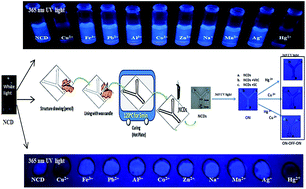
Nanoscale Adv., 2019,1, 592-601
https://doi.org/10.1039/C8NA00080H
Intracellular ratiometric temperature sensing using fluorescent carbon dots
A self-referencing dual fluorescing carbon dot-based nanothermometer can ratiometrically sense thermal events in HeLa cells with very high sensitivity.
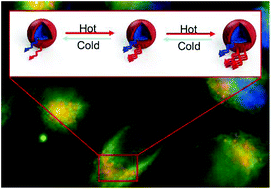
Nanoscale Adv., 2019,1, 105-113
https://doi.org/10.1039/C8NA00255J
About this collection
This topical collection highlights nanoscale-based research on quantum and carbon dots published so far in Nanoscale Advances. It includes reviews on the progress made so far, and original research showcasing the latest thinking on the synthesis, applications and properties of nanoscale dots.